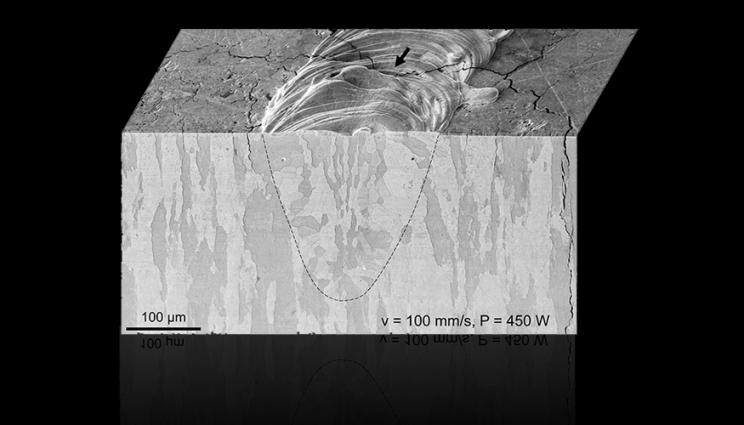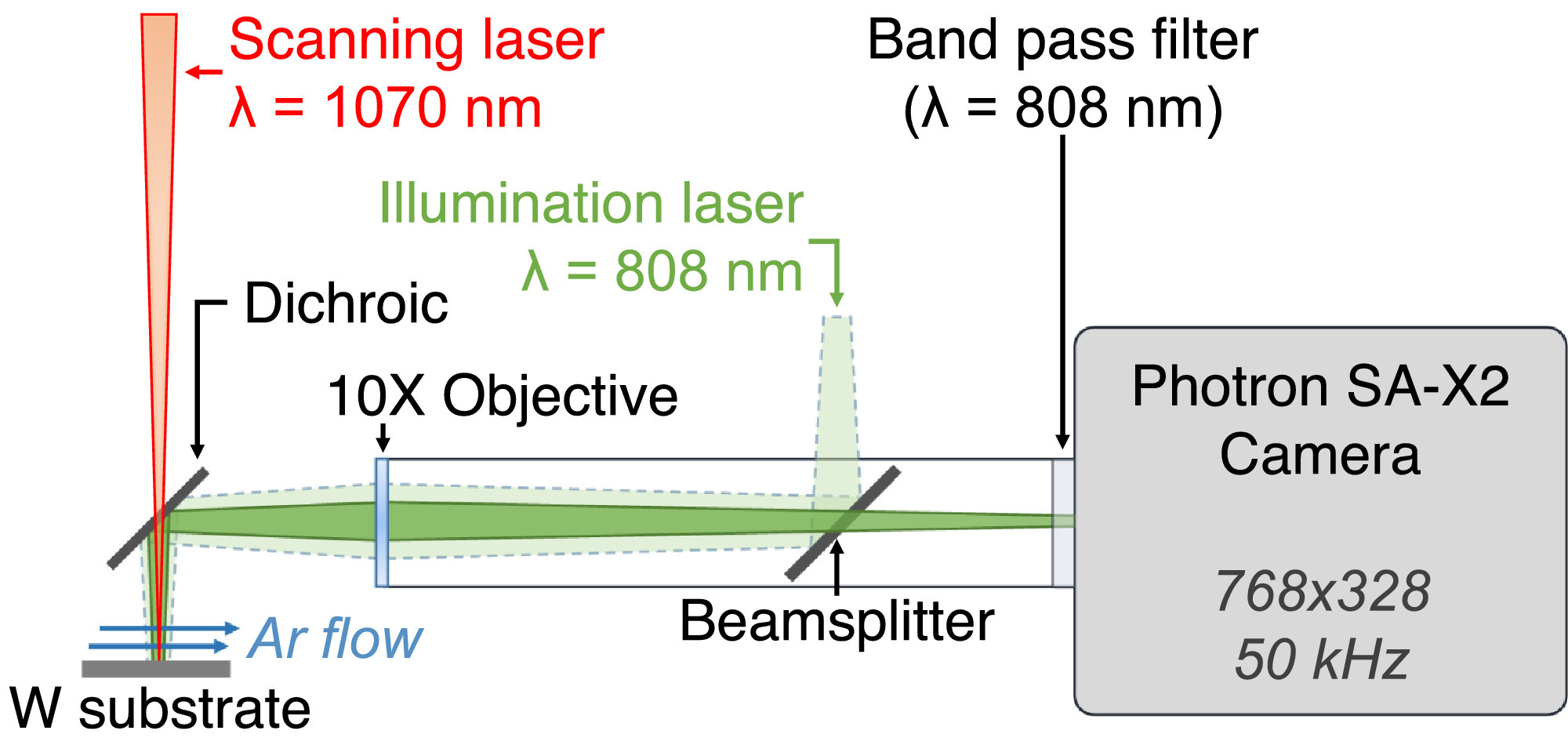Researchers from Lawrence Livermore National Laboratory (LLNL) have identified the reasons behind microcracking observed in tungsten during additive manufacturing.
By combining simulations with high-speed video, the researchers were able to visualize the Ductile-to-Brittle Transition (DBT) of tungsten during 3D printing in real-time. Leveraging their monitoring technique, the team pinpointed variables such as residual stress, strain rate, and temperature as the reasons behind the cracking. The scientists’ discovery could act as a basis for 3D printing other crack-free metal parts, with potential applications in the defense and energy industries.
“Due to its unique properties, tungsten has played a significant role in mission-specific applications for the Department of Energy and Department of Defense,” said the team’s Co-principal Investigator Manyalibo “Ibo” Matthews. “This work helps pave the way toward new additive manufacturing processing territory for tungsten that can have significant impact on these missions.”
Tungsten’s microcracking tendencies
Tungsten is a metal 3D printing material characterized by moderate thermal expansion, and a high melting point and thermal conductivity. The alloy’s thermomechanical properties, alongside its high density and low sputter erosion rate, make it well-suited to applications in extreme environments. Despite tungsten’s favorable traits, its widespread adoption has been limited by its lack of thermal shock resistance and brittleness at low temperatures.
The DBT transition is pivotal in determining the limits of a printing material’s lower thermal working range. DBT is inevitably encountered when metals are cooling down after being exposed to high temperatures, such as those that occur in 3D printing. The lower temperatures lead to a dramatic loss of ductility, causing residual stresses and microcracking.
During Laser Powder Bed Fusion (LPBF) printing, the rapid and continued heating of materials can also lead to high residual stresses, creating distortions in the final product. Although it’s understood that DBT causes microcracking in LPBF 3D printed tungsten, the exact reasons why this occurs has remained a mystery. Previous researchers have experimented with adding nanosized ZrC powder to tungsten, but results were mixed.
In 2018, KU Leuven scientists found that adding ZrC made no difference, whereas research from Tsinghua University saw residual stress reduced by 80 percent. In an attempt to find a conclusive answer to the causes of microcracking, the LLNL team developed a method of monitoring LPBF printing in-situ to study the DBT transition in closer detail.

The LLNL team’s in-situ observation method
In order to fully-evaluate the correlation of cracking with temperature-induced stress, the LLNL scientists employed a Photron SA-X2 high-speed camera. The equipment was focused on the center of the track, with the laser scanning across the image. Utilizing a Navitar Zoom 6000 system, single 2 mm long tracks were summarily scanned along a tungsten plate.
Gaussian beam diameters of 50 µm and 100 µm were then used to investigate the effect of beam spot size on the process, with 20 repetitions of each parameter being tested. Deploying the LLNL’s Diablo Lagrangian element code software, the researchers later carried out thermal and thermomechanical simulations of the tracks on the tungsten substrate.
Even though half symmetry was used to reduce the size of the simulations, each one employed approximately 1 million elements, requiring computation times of around 1,000 cpu-hours each. Testing results revealed a delay after the passage of the melt pool before a crack began to appear. Increasing laser power from 250 µm to 600 µm before the onset of longitudinal fractures, also led to wider spacing between them.

As a result, the team concluded that the longitudinal cracks partially relieved the residual stress of the alloy, and led to fewer transversal breaks along the part. Simulations also revealed that a deep melt pool shape can often lead to the formation of thin, vertically oriented grains in the middle of the solidified pool, which easily allow cracks to occur.
In order to tackle the residual stresses involved in DBT, the team found that a universal strategy that combines optimized machine parameters with the material’s makeup is required. Preheating and controlling oxygen levels inside the build chamber was identified as important in lowering strain rates, as was the concentration of impurities within the alloy.
Overall, the LLNL team believes their findings to be a strong first step towards their goal of 3D printing crack-free tungsten parts for applications in extreme environments. “I had hypothesized that there would be a delay in the cracking for tungsten, but the results greatly exceeded my expectations,” concluded Bey Vrancken, LLNL Fellow, and the paper’s lead author.
“The thermomechanical model provided an explanation for all our experimental observations, and both were detailed enough to capture the strain rate dependence of the DBT. With this method, we have an excellent tool to determine the most effective strategies to eliminate cracking during LPBF of tungsten.”
Tungsten in the 3D printing industry
Tungsten has been utilized for a wide range of applications in recent years by researchers and companies alike. Binder jet 3D printer provider ExOne has entered into a collaboration with Global Tungsten & Powders Corp to advance the use of tungsten powders in binder jet manufacturing. The collaboration is expected to optimize the alloy for producing cutting tools, wear-resistant parts, and high electrical and thermal conductivity applications.
Scientists from the Institute of Cancer Research (ICR) and Royal Marsden Hospital used 3D printed tungsten disks within a gamma camera for higher resolution medical imaging. The imaging technique captured traces of radiation emitted by pharmaceuticals that are injected into cancer patients.
The University of Pittsburgh and General Carbide, a manufacturer of compound metals, received a $57,529 grant to research the use of tungsten carbide in 3D printing. The joint-research arrangement allowed General Carbide to share the cost of expanding its portfolio while developing more complex and versatile parts.
The researchers’ findings are detailed in their paper titled “Analysis of laser-induced microcracking in tungsten under additive manufacturing conditions: Experiment and simulation,” which was published in the Acta Materialia journal. The report was co-authored by Bey Vrancken, Rishi K. Ganeriwala, and Manyalibo J. Matthews.
Nominations for the 2020 3D Printing Industry Awards are still open, let us know who is leading the industry now.
The fourth edition of the 3D Printing Industry Awards Trophy Design Competition is now underway. Enter your design for the chance to win a CraftBot Flow 3D printer.
To stay up to date with the latest 3D printing news, don’t forget to subscribe to the 3D Printing Industry newsletter or follow us on Twitter or liking our page on Facebook.
Are you looking for a job in the additive manufacturing industry? Visit 3D Printing Jobs for a selection of roles in the industry.
Featured image shows a tungsten substrate used by the LLNL researchers to test their approach. Image via LLNL.



